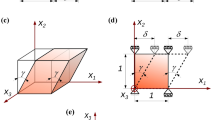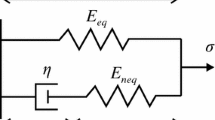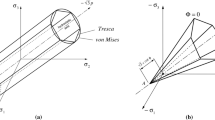Abstract
In this paper, constitutive integration for rate-independent, small deformation elastoplasticity is studied. Smooth yield surfaces and work/strain hardening are assumed. Both associative or non-associative flow rules are considered. An Euler backward algorithm is applied for constitutive integration. Tangent moduli that are consistent with the Euler backward algorithm, i.e. a so-called consistent tangent operator, are derived. Emphasis is placed on numerical implementation of the Eular backward algorithm into finite element codes using such a consistent tangent operator. In particular, a commercial code ANSYS is considered. Numerical examples, including materials sensitive and insensitive to hydrostatic stress, are used for the verification of the implementation. A comparison of the algorithmic performance to an explicit Euler forward algorithm is given and the superiority of the Euler backward algorithm is demonstrated.
Similar content being viewed by others
References
Andesen, R. 1995: Finite element simulation of multiaxial cube tests of columnar, saline laboratory ice, Report NTAS A 95029 NORUT Teknologi AS, Norway
Crisfield, M. 1987: Consistent schemes for plasticity computation with the Newton-Raphson method, Proc. of Int. Conf. on Computational Plasticity, Swansea, Pineridge Press, 133–159
Crisfield, M. 1992: Non-linear Finite Element Analysis of Solid and Structures, Vol. 1, John Willey and Sons
Hill, R. 1950: The Mathematical Theory of Plasticity, Oxford University Press, New York
Horrigmoe, G.; Zeng, L. F. 1993: Constitutive modelling of ductile failure of columnar ice, Report No. FTAS A 93049, NORUT Teknologi AS, Norway
Horrigmoe, G.; Zeng, L. F. 1994: Modelling ductile behavior of columnar ice using computational plasticity, Proc. of 12th Int. Symp. on Ice (IAHR94), Trondheim, Norway, Vol. 1, 282–291
Krieg, R. D.; Key, S. W. 1976: Implementation of time independent plasticity theory into structural computer programs, in Constitutive Equations in Viscoplasticity, Computational and Engineering Aspects (eds: J. A. Stricktin and K. J. Saczakki), AMD-20, ASME, NY, 125–138
Matzenmiller, A.; Taylor, R. L. 1994: A return mapping algorithm for isotropic elastoplasticity, Int. j. numer. methods eng., Vol. 37, 813–826
Mitchell, G. P.; Owen, D. J. R. 1988: Numerical solutions for elastic-plastic problems, Eng. Comput. Vol. 5, 276–284
Ortiz, M.; Popov, E. P. 1985: Accuracy and stability of integration algorithms for elastoplastic constitutive relations, Int. j. numer. methods eng., Vol. 21, 1561–1576
Ortiz, M.; Simo, J. C. 1985: An analysis of a new class of integration algorithms for elastoplastic constitutive equations, Int. j. numer. methods eng., Vol. 21, 1561–1576
Owen, D. R. J.; Hinton, E. 1980: Finite Elements in Plasticity, Theory and Practice, Pineridge Press Ltd, Swansea, UK.
Reinicke, K. M.; Remer, R. 1978: A procedure for the determination of ice force-illustrated for polycrystalline ice, Proc. of 5th Int. Symp. on Ice (IAHR 78), Luleå, Sweden, 217–238
Runesson, K.; Samuelsson, A. 1985: Aspects on numerical techniques in small deformation plasticity, NUMETA 85 (Numerical Methods in Engineering: Theory and Applications, eds: J. Middleton et al., Swansea, UK), Vol. 1, 337–348
Runesson, K.; Sture, S.; Willam, K. 1987: Integration in computational plasticity, Computers and Structures, 30, 119–130
Sanderson, T. J. O. 1986: Ice Mechanics: Risks to Offshore Structures, Graham and Trotman, London, UK
Simo, J. C.; Oritz, M. 1985: A unified approach to finite deformation elasto-plastic analysis based on the use of hyperelastic constitutive equations, Compt. methods appl. mech. eng., Vol. 49, 221–245
Simo, J. C.; Taylor, R. L. 1985: Consistent tangent operators for rate-independent elastoplasticity, Compt. methods. appl. mech. eng., Vol. 48, 101–118
Simo, J. C.; Taylor, R. L. 1986: A return mapping algorithm for plane stress elastoplasticity, Int. j. numer. methods eng., Vol. 22, 649–670 Swanson Analysis Systems, Inc. 1994: ANSYS (Rev. 5.1) Programmer's Manual, Vol. 5, Theory, Houston, USA
Theocaris, P. S.; Marketos, E. 1964: Elastic-plastic analysis of perforated thin strips of strain hardening materials, J. Mech. Phys. Solids, 12: 377–390
Wilkins, M. L. 1964: Calculation of elastic-plastic flow, in Methods of Computational Physics (eds B. Alder et al.), Vol. 3, Academic Press
Zeng, L. F.; Horrigmoe, G. 1994: An Euler forward algorithm enhanced with subincrements and one-step Euler backward return for constitutive integration in rate-independent elastoplasticity. Report No FTAS 94042, NORUT Teknologi AS, Norway
Zienkiewicz, O. C.; Taylor, R. L. 1992: The Finite Element Method, Vol. 2, 4th edn, McGraw-Hill, New York
Author information
Authors and Affiliations
Additional information
Communicated by S. N. Atluri, 10 April 1996
The work described in the present paper has been sponsored by The Research Council of Norway, The North Calotte Education and Research Council, Statoil and Norsk Hydro.
Rights and permissions
About this article
Cite this article
Zeng, L.F., Horrigmoe, G. & Andersen, R. Numerical implementation of constitutive integration for rate-independent elastoplasticity. Computational Mechanics 18, 387–396 (1996). https://doi.org/10.1007/BF00376135
Issue Date:
DOI: https://doi.org/10.1007/BF00376135




